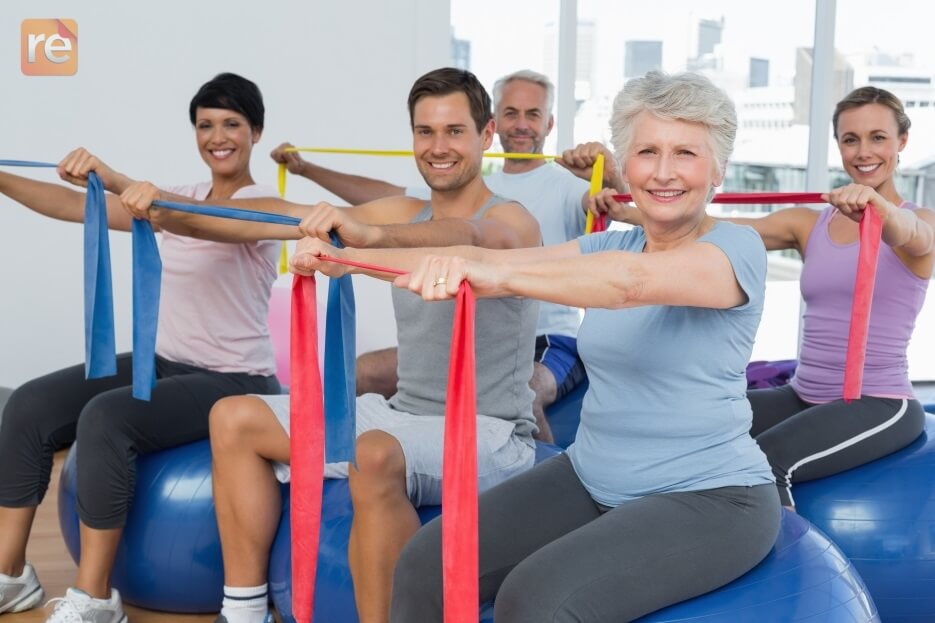4.6 million people in Canada report suffering from arthritis, stiff, painful joints can make even an easy exercise program feel impossible.
With countless research studies backing up the benefits of working out, can your loved one really afford to forgo their daily cardio? The experts don’t think so.
There is nothing better, than exercise when it comes to managing pain in people with arthritis. Though, it can be hard for people who are in pain to stick to an exercise routine. Arthritis pain can prevent a person from exercising, but it is actually one of the most beneficial ways to alleviate arthritis pain.
Thankfully, there are ways to make an exercise regimen more arthritis-friendly:
Prioritize pain management
The key to a successful exercise program for people with arthritis is making sure their pain is under control before they start working out. This will involve a trip to your loved one’s doctor to diagnose which type of arthritis they have, and prescribe any necessary anti-inflammatory medications or therapies. Once their pain and inflammation are under control, a senior should be able to do most types of exercise without aggravating their condition. A doctor can also advise an arthritis sufferer about which kinds of exercises would be best to do, as well as which ones could be harmful.
Start slow
A warm-up is an often overlooked, yet integral element of a workout—especially when a senior’s joints are stiff and sore due to their arthritis. Before your loved one hops on a bike or picks up dumb bells, they should do some gentle range-of-motion exercises (generally prescribed by their doctor or physical therapist), such as arm circles, hip lifts, and toe touches. It might also be beneficial for a senior to put a heat pack on their most painful areas prior to starting a workout. Heat can help relax and loosen up their muscles and joints.
Reduce your impact
When it comes to exercising with arthritis, low-impact is the way to go. Swimming, water aerobics, stationary cycling, and elliptical machines as great low-impact forms of cardiovascular training. The practice of Tai Chi as a way to help a senior increase their balance and flexibility. Studies have shown that this ancient Chinese martial art can help reduce pain and increase mobility in people with different types of arthritis. It’s generally safe for an arthritis sufferer to lift weights, just be sure to check with your loved one’s doctor before encouraging them to begin a weight training program.
Mix it up
Switching up an exercise regimen can be extremely beneficial for a senior who is suffering from arthritis. Workouts should be varied—not stagnant. There are numerous benefits to mixing it up in the gym, the least of which is that your loved one is less likely to become bored and uninterested in working out. It’s important to consult with your loved one’s doctor to come up with a workout plan that focuses on safely developing their cardiovascular capacity as well was their all-around strength and flexibility.
In pain, no gain
Doctors warn arthritis-suffers to avoid workouts that cause them pain. Exercise should only be done up to a point where you feel tired,not exhausted and it is never good to push through pain. Pain is your body’s way of telling you that something is wrong. Especially if your loved one suffers from rheumatoid arthritis, it is emperative that they see their doctor to make sure their inflammation is under control before they start an exercise program.
Work on weaknesses
When it comes to strength training, a senior might want to stick with the exercises that they’re good at. It’s equally, if not more important for your elderly loved one to work on increasing strength in their weaker areas. Some of the most beneficial types of exercises a senior can do are those that strengthen the muscles that support their arthritic joints. A doctor or physiotherapist can help your loved one come up with a set of exercises tailored to strengthening the areas around their pain points.
Recover well
Stretching before and after a workout can help a senior’s muscles recover more quickly. If your loved one is particularly sore in certain areas, it may be beneficial for them to ice those parts of their body. When icing, make sure the ice pack is wrapped in a thin towel and don’t leave it on the skin for longer than 30 minutes.
Don’t forget to eat well
There’s no magical diet that can take away aches and pains, but eating healthy can beneficial for seniors who have arthritis. Tailor your loved one’s diet to fit their exercise regimen.
For example, if a senior is engaging in a good amount of strength-building exercises to build up the muscles around their joints, make sure they’re getting enough healthy protein (egg whites, almonds, chicken, salmon, etc.) to help fuel muscle growth. If they’re doing a good amount of cardio, make sure they’re eating high-quality carbohydrates (fruit, whole grain pasta, bread, brown rice, etc.).

